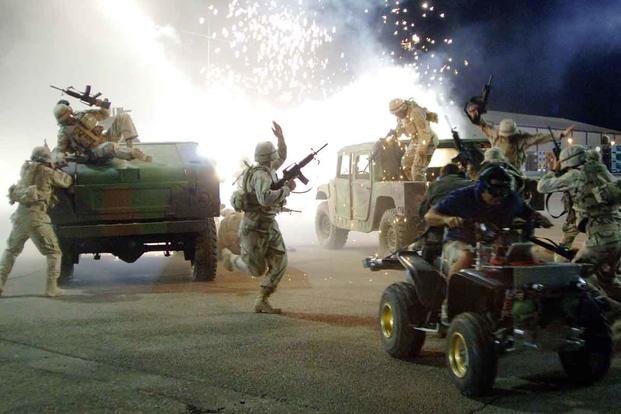No matter how big a Hollywood film budget gets, it will never quite reach Pentagon-level funding. It would be silly to compare the $738 billion budget the Defense Department has at its disposal with anything a movie studio can spend.
The most expensive movie ever made was "Pirates of the Caribbean: On Stranger Tides" at a staggering $379 million. And it wasn't even good. The best weapons you could buy with that are some MQ-1 Predator drones, Chinook helicopters or ICV Strykers.
So Hollywood needs a little help when it comes to getting real military hardware to entertain the masses. And why not? We might as well get a little entertainment from our hard-earned (and easily spent) tax dollars.
That's where Glen Roberts, the Pentagon's liaison to the motion picture industry, comes in. Roberts reads scripts and then works with studios to make military-themed productions as realistic as possible.
He sat down for Military.com's "Left of Boom" podcast with Managing Editor Hope Hodge Seck to talk about why the U.S. military agrees to help Hollywood, and how producers get real U.S. troops to hang out with Iron Man.
Roberts is the Defense Department branch chief for Entertainment Media, the first stop for films looking to get military help. It was his office that helped the Navy and Paramount Pictures make the upcoming "Top Gun: Maverick" and Brie Larsen's Captain Marvel don an Air Force flight suit.
"Our mission, you know, our formal explanation is that we inform and educate the public, both the domestic and the foreign public, on the roles and missions of the Department of Defense," said Roberts, an Air Force veteran. "That's why we exist, really, to make sure that Americans know that their taxpayer dollars are being used in good stewardship."
He goes on to say that his office's role is to protect the DoD's credibility and image in the entertainment industry.
To get support from a branch of the military, you start by choosing which branch and then apply for help. From there, the liaison office will reach out for a more in-depth discussion.
Just how the Pentagon chooses which films to support comes down to several factors. But simply put, if the film has a big budget or is already sold to a studio, it's more likely to get military support.
"There's a lot of folks that want to come shoot the movie, but they don't have funding, or they don't have distribution," Roberts said. "We need to make sure that we're good stewards of the taxpayers' money and their resources. And we only utilize those resources and make them available for things that are really going to be seen in the public eye."
So forget about making the film first and then trying to sell it at Sundance.
As for content, the liaison office looks for films that support the military's core values, uphold the integrity of those who serve and at least display the military's professionalism.
"It doesn't mean that there can't be a bad person, a villain per se, who is in uniform, as long as it actually upholds the integrity of the men and women in uniform and the ability to do their job," Roberts said. "Humor is good. We laugh at ourselves; we're happy to laugh at ourselves. Like I said, it's not unheard of to have a bad guy or bad gal, so to speak in a villain's role."
Roberts adds that he isn't the one person who can make or break a production. He can approve the script for support, but he can't task military units to help out. The office takes the project to the services, who will approve or disapprove. If they approve, his office helps with the logistics.
For more about how and why the Pentagon helps produce Hollywood films with military firepower, listen to the entire interview with Glen Roberts, DoD branch chief for Entertainment Media, and tune in to new episodes of Military.com's "Left of Boom" podcast on iTunes, Google Podcasts, Spotify, TuneIn and Stitcher.
Follow host Hope Hodge Seck on Twitter @HopeSeck.
-- Blake Stilwell can be reached at blake.stilwell@military.com. He can also be found on Twitter @blakestilwell or on Facebook.
Want to Learn More About Military Life?
Whether you're thinking of joining the military, looking for post-military careers or keeping up with military life and benefits, Military.com has you covered. Subscribe to Military.com to have military news, updates and resources delivered directly to your inbox.

















